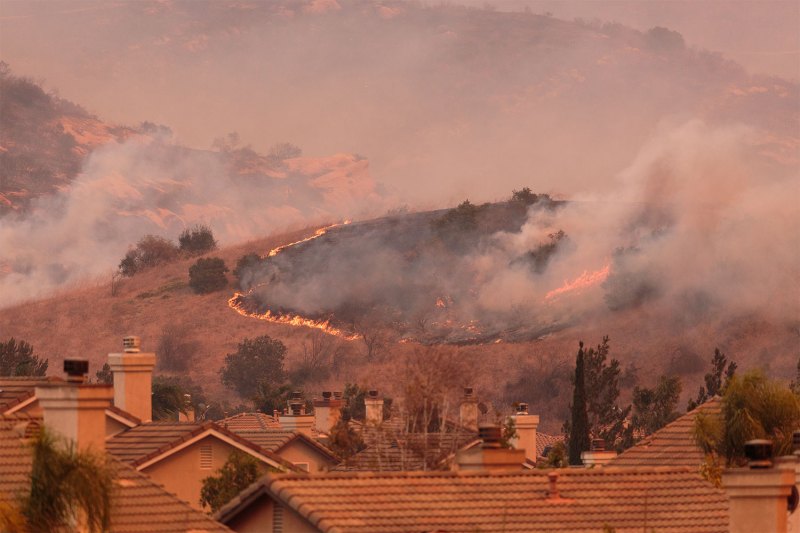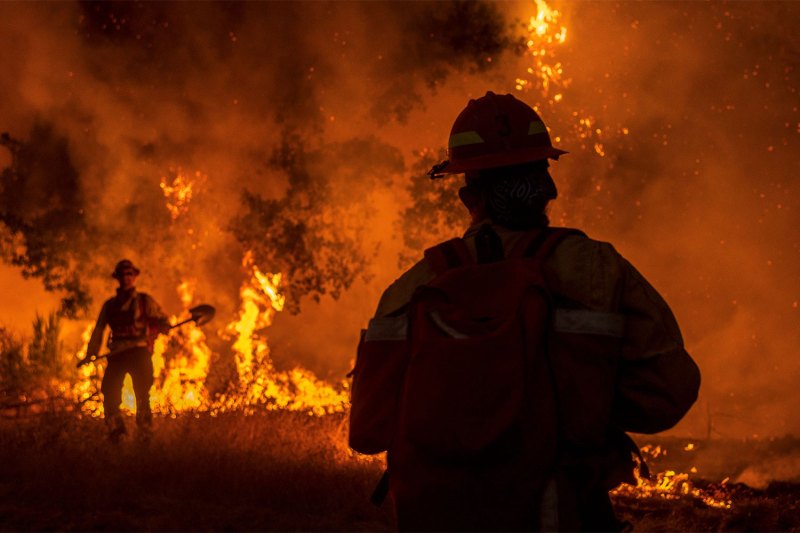As a kid growing up in southern California, I always thought of earthquakes as our state’s signature danger. Some states had tornadoes that lifted their houses off the ground and threw them into trees, or alligators that crawled out of their toilets. (So I heard, anyway.) By comparison, earthquakes were great fun — I said as much to midwestern cousins who asked me about them in breathless tones. I can remember giggling in excitement during the one “serious” earthquake that visited our duplex in the suburbs of San Diego. It lasted about ten minutes and wrought no worse damage than a picture falling off the wall — the glass didn’t even break.
Maybe that’s why it’s been so hard for me to come to grips with the annual wildfires that have been ravaging the west coast since the year I left for college. I got so used to dispelling people’s exaggerated notions about California that I almost can’t believe the news, about 3,754,729 acres burned, 28 human lives lost, and over 7,000 homes and structures damaged. (And those numbers are just California. Add in the stats from Oregon, Washington, Idaho and elsewhere, and you’re looking at 4.5 million or more acres burned.)

The weirdest part about it, for me, is that this disaster is now a regular thing — you can practically pencil it into the calendar. My friends and family on the west coast have begun referring to early autumn as “fire season,” said with a roll of the eyes, as if they’re talking about rush hour on I-5. Californians are great at putting up with the downsides of modern life, like a 3-hour commute and high property taxes. But from this remove, it seems sort of like a human right that you shouldn’t have to put up with the imminent threat of losing your life and livelihood every year.
That’s why, as I look for ways to support relief efforts for the wildfires in California as well as Oregon and Washington, I make a point of looking for organizations that are actively working to improve forestry practices and fight climate change. In case anyone needs reminding, a major factor in these fires is our planet’s increasing temperature, which turns those western grasslands and forests into a tinder box.
As a former west coaster with the Golden State still very much in my heart, I thank you for your generosity and concern for your fellow citizens. The West holds an important place in our collective imagination — it’s worth holding onto.
General Resources
Whether you want to help wildfire victims in California, Oregon, Washington, or Colorado, there are a few national organizations that are on the front lines of relief in every area affected by the natural disaster.
One important thing to bear in mind: As the situation is changing constantly, these resource centers are also shifting their priorities and needs. Before you donate, double-check the latest updates from the organization you have in mind, to ensure that your effort will be successful.
Red Cross
The Red Cross has been on the frontlines of wildfire relief since the beginning. They also make it super easy to donate: Just text WILDFIRES to 90999 and you’ll send $10 to fire relief efforts in Oregon and Washington. To donate to California relief efforts, text CAWILDFIRES to the same number. (Donations can also be made online.)
The United Way
The United Way has established a dozen local relief funds in CA, OR, and WA to provide immediate support to wildfire victims. The below sites are aggregate resource centers serving multiple regions affected by the fires.
California
- United Way of Northern California — Covers 9 counties in California’s northernmost region.
- Greater Bay Area Central Coast Wildfire Relief Fund — Covers 15 counties in the Bay Area and Wine Country.
- Inland Southern California United Way — Helping victims of El Dorado Fire in Oak Glen.
Oregon
- United Ways of the Pacific Northwest — Contributes to Oregon, Idaho, and Washington. This site also includes a list of United Ways in specific counties to give more directly.
Washington
GoFundMe.org has a Wildfire Relief Fund that will issue grants to individuals, organizations, and communities that have either been impacted themselves or are dedicated to helping those affected by wildfires. You can make a general donation on the main page, or find their individual pages for specific regions affected by the fires.

Supporting the Undocumented/Immigrant Victims of the Wildfire
During Australia’s rash of wildfires last spring, there was as much attention given to the wildlife displaced and harmed by the fires as the human loss of life and property. Out West, there’s a similarly affected sector: The undocumented immigrant population. Thousands of refugees and seasonal workers, as well as families of mixed status, wind up in these areas to earn a living as agricultural workers. Living right at the poverty line, if not below it, they are perhaps the most vulnerable to the disaster, with nowhere to go and no resources to shore them up during the halt in work. Not only does the language barrier and fear of immigration enforcement prevent them from seeking help, but because of their undocumented status, they are disqualified from receiving any FEMA assistance.
In California, the UndocuFund for Fire Relief in Sonoma County was formed in 2017 to support undocumented immigrants who lost homes, jobs, and wages in the wildfires.
The Center for Disaster Philanthropy supports local agencies in areas affected by the wildfires who work with vulnerable populations, such as undocumented workers and people living in poverty.
In Oregon, Unete has been working for years providing services for migrant workers and their families.
A few more region-specific organizations include:
California Fire Foundation’s Supplying Aid to Victims of Emergency (SAVE) program provides immediate, short-term relief to wildfire victims, ensuring they receive necessities like groceries and medicine.
Latino Community Foundation Wildfire Relief Fund supports Latino-led grassroots organizations who provide critical financial assistance, rehousing support, and emergency translation for Latino and immigrant families.
California Wildfire Relief Fund provides long-term assistance as well as immediate relief for victims.
Rogue Valley Relief Fund provides for immediate needs such as tents, meals, gas, and other supplies.
Finally, there’s the big-picture relief issue: Finding an environmental solution to help curtail the pattern of these major wildfires. Experts agree that two major issues are to blame for these seasonal disasters. One, no surprise, is climate change, which accounts for the high temperatures and strong winds that increasingly turn the west into a tinder box in late summer. But the other is decades of improper forest management. The following organizations specialize in research, lobbying, and public education and awareness around both these issues–a donation with them is an investment in our collective future:
- Center for Climate and Energy Solutions
- Conservation Northwest
- Environmental Defense Fund
- National Forest Foundation
- Oregon Environmental Council


